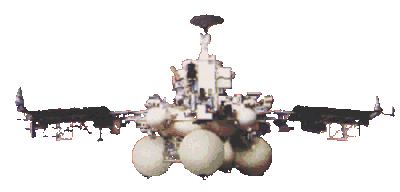PHOBOS-2 MARS SPACECRAFT

The Phobos Mars mission was an ambitious plan to launch 2 similar spacecraft not only to orbit the planet Mars, but to rendezvous with Mars's moon - Phobos. The plan was, for the 2 spacecraft to initially orbit Mars, and then gradually alter their orbits over several months to allow a rendezvous with the moon Phobos to take place. As the spacecraft would fly by Phobos, the plan was for them to drop a number of surface probes onto the moon Phobos from the incredibly close altitude of 50 metres.
The Phobos-2 spacecraft was launched on the 12th of July, 1988 from the Baikonur Cosmodrome in Kazakhstan. The spacecraft was launched on a Proton D-1e 4-stage rocket.
Launch Vehicle Details
|
The Phobos-2 spacecraft arrived at Mars on the 30th of January, 1989, but all communication with the spacecraft was lost on the 27th of March, 1989, following a computer system malfunction onboard the spacecraft.
Phobos Spacecraft Details
|
TERMOSKAN
The Termoskan (translated into English as Thermoscan) instrument consisted of a two channel optical mechanical scanning radiometer, spectrally sensitive in the range of 8.0 - 13.0 microns, and with a spatial resolution of 1.8 km x 1.8 km per pixel from a 6000 km orbit, and using a liquid Nitrogen coolant. The two channels of the Thermoscan radiometer also allowed reflected planetary radiation to be received, thus the infrared and visible brightness values could be compared against each other.
By modern standards, Termoskan's resolution was pretty low, but this was not really an issue, since the most useful thing about Termoskan, was the fact that thermal infrared images could be obtained, and then compared against visible images. This was of major significance for the research with which I was involved, since I was trying to calculate thermal inertia and examine a number of small localised areas of 1 - 2 pixels in size, displaying considerably higher radiant temperatures than their surroundings (250 K - 265 K against 240 K - 245 K) in one particular region of Mars (located at 225° - 235° longitude, and -10° - -20° South, latitude, to the East of Hesperia Planum, and with the crater Herschel as the most notable physical feature).
Orbiting at approximately 6000 km above the Martian surface, the Termoskan instrument onboard the Phobos-2 spacecraft, was able to image large swathes of the equatorial region of Mars at a resolution of 1.8 km x 1.8 km, thus enabling the first detailed thermal map of Mars to be built up. The infrared images returned were of much higher resolution and sharpness than those in the visible waveband, mainly due to atmospheric haze that blurred the visible images. If Phobos-2 hadn't broken down so soon after reaching Mars, no doubt the data returned would have been vastly more impressive.
Just as a point of note for anyone interested, the code we used to analyse the Termoskan images in St Petersburg, Russia, and then subsequently in the U.K. was written in Borland TurboC on what at the time, were state of the art Intel 80286 and 80386 CPU based PCs.
More recently, data from the Hesperia Planum region of Mars has been obtained by the THEMIS (Thermal Emission Imaging System) instrument onboard the Mars Odyssey Spacecraft. This is of considerably higher resolution than that of Termoskan.
GETTING TO MARS
I've heard many people say, "why do things pack up at Mars ?", well the thing to remember, is these spacecraft are travelling for many months, over many millions of miles, bombarded by cosmic rays, to reach their destination. The fact that they get there at all is pretty impressive - orbital mechanics is not trivial.
However, this is far from the only problem, one of the biggest problems, is deep space vehicles are generally built in ones or twos. By any other engineering criteria, they'd be the equivalent of prototypes. Prototypes of more terrestrial bound vehicles are generally used for testing - with spacecraft, they're not, they're slung out into the solar system and expected to work. Not surprisingly, they do sometimes break down.
The 2 Phobos spacecraft were designed to use an interplanetary bus configuration which could be utilised on future missions, providing some degree of commonality. One of the problems though, was the vehicles were not neccesarily really ideal platforms for low level fly bys of low gravity planetary bodies, but might have been better suited to just breaking into Mars orbit.

